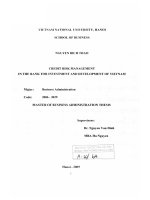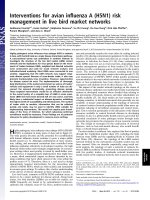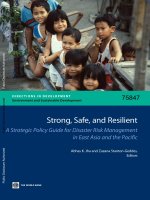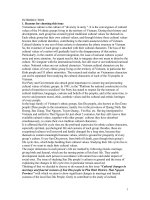Credit risk management in agribank – thai nguyen province
Bạn đang xem bản rút gọn của tài liệu. Xem và tải ngay bản đầy đủ của tài liệu tại đây (206.5 KB, 19 trang )
PREFACE
In this summary dissertation, all figures and tables are numbered as presented in the
dissertation
Activities of banks currently face many difficulties due to the economic crisis.
Specifically, these crises affect the business results of all economic sectors. Before the
integration trend, banks have been facing stiff competition as well as various types of risk.
Until now, the risk management of banks in Vietnam is almost left open and has not
invested in contruction in a satisfactory and professional manner. This is the reason why the bad
debt ratio and many problems have occurred due to inability to control the occurrence of
management problems that remained
an urgent issue which has not been resolved. The
management of credit risk has become vital significance for the development of the banks,
particularly Bank of Agriculture and Rural Development.. To minimize the risk of credit
performance, managers must assess the risk of credit products and factors affecting credit risk.
Thus, the researcher has chosen the topic "Credit Risk Management at Bank of Agriculture and
Rural Development - Branch of Thai Nguyen, Vietnam"
The structure of dissertation includes 5chapters.
CHAPTER I: INTRODUCTION
Background of study
This dissertation assessed the status of the level of credit risk of the Bank for Agriculture and
Rural Development, Thai Nguyen province through the risk assessment of the debts which were
categorized by criteria: segment structure, type of borrowers, type of guarantee , and outstanding
accounts.
Through survey results, the data were collected to determine the credit risk of debt through the
use of Likert scale.
Thesis reviews are the factors affecting credit risk through two (2) groups of objectives and
subjective factors
Statement of problem
Based on the objectives of the thesis, the research questions are as follows:
1. What is the profile of the respondents in terms of:
a) Age
b) Gender
c) Civil status
d) Education
e) Year in service
2. What is the assessment of the managers and staffs of Agribank Thai Nguyen credit risk
management in terms of:
a) Segment structure
b) Types of customers
c) Types of guarantee
d) Account outstanding
3. What is the assessment of the managers and staffs of Agribank Thai Nguyen on the credit
risk management in terms of:
a) Overdue Debt
b) Undue Debt
c) Debt requiring attention
d) Under qualified Debt
e) Doubtful Debt
f) Frozen Debt
g) Bad Debt
4. What is the assessment of managers and staff on the factors affecting credit risk
management of Agribank Thai Nguyen in terms of:
a) Subjective creteria
b) Objective creteria
5. What design improvement on the credit risk management of Agribank Thai Nguyen can
be proposed to minimize credit risk?
6. Is there a significant difference in assessment of two groups of respondents on credit risk
management and factors affecting the limitation of credit risks of the bank?
Significance of the Study
The results of this research will benefit the following:
To the Manager. This will provide them with valued information concerning the credit risk
management of the branch. In this regard they will be able to adapt their development
programs to help the bank reduce credit risk management.
To the Researcher. The researchers as an employee of bank and as a candidate for Doctor of
Business Administration Degree, this study will enhance his knowledge that he can use
and apply to the bank in the future.
To Future Researchers. This can serve as reference materials for future researches similar to
this.
Scope and Delimitation
This study chose the topic on the credit risk management at the Bank for Agriculture and
Rural Development in Thai Nguyen province.
The researcher studied the present situation of credit risk in terms of bad debts, undue
debts, overdue debts, debts requiring attention, under qualified debts, doubtful debts and frozen
debts. as perceived by managers and staff of the Agribank, and from that, the researcher
recommended the appropriate solutions to limit credit risk in effective ways in bank.
The study was conducted at bank branches of Agriculture and Rural Development of
Thai Nguyen. The survey period was from 9/2012 to 3/2013. The data gathered about the
operation of the bank covered the fiscal years 2011 and 2012. The study only focused on credit
risk activities, not to mention the risk of other activities at the bank.
CHAPTER II
REVIEW OF LITERATURE AND RELATED STUDY
This section presents the basic concepts, the contents related to credit operations of banks sorted
by the variables studied.
Conceptual Framework
Research Framework describes briefly how to define the problem, to which the authors propose
solutions to mitigate credit risk based on the selected variables.
CHAPTER III
METHODOLOGY
Research design
The research design was chosen with the purpose of gathering data regarding the credit
risk in Agribank and how to limit this. Moreover, the researcher analyzed the remained issues,
assessed them and founbd out the best way to handle these and how to limit the credit risk in the
Agribank system.
The research used the descriptive method which included quantitative and qualitative
analysis of data. And the main source of data was deetermined from the questionnaire. The
respondents were managers and staff of Agribank Thai Nguyen. The Managers were chief of
some departments and members of the management board in Agribank. Apart from the
questionnaire, the researcher also used the information and data from the Financial and
Accounting Department, Investment and Planning Department, including data from financial
statements, profit and loss statements, etc.
Population and Sampling
Due to the large number of population, the Slovin’s formula was used to identify the
sample size:
n=
N
1 Ne 2
where n = A sample size
N = Population size
e = Probability of error committed due to the use of sample instead of population.
With the total population equal to 415 people. If the confidence interval is 95%, e is 5%:
n = (415/(1+ 415/ 0,052)) = 203.6
Given the population and sample size, and due to the limitation of time and
resource, the sample of 203 is acceptable and recommended.
Research Instruments
The research study made use of a questionnaire which is divided into two parts as
follows:
- Part I: Respondent’s profile as to age, gender, working position, working experiences.
- Part II: This part measures the assessment of the respondents on the risk management
and factors affecting to credit risk management of Agribank Thai Nguyen.
The researcher also utilized the 5 Likert Scale to present and interpret the responses based
on their averages.
Scale
Intervals
Evaluating level
5
4.20– 5.00
Most Risky (MsR)
4
3.40– 4.19
More Risky (MrR)
3
2.60 – 3.39
Risky (R)
2
1.80 – 2.59
Less Risky (LR)
1
1.00 – 1.79
Least Risky (LsR)
Statistical treatment
To provide interpretation to the data gathered, the study applied statistical tools,
including:
- The qualitative and quantitative factors regarding the remaining problems on the limit
of credit risk in Agribank Thai Nguyen were calculated by frequency distribution or percentage.
- The 5 points questionnaire to assess the present conditions of the limit of credit risks in
Agribank Thai Nguyen and the statistical data were calculated by frequency distribution or
percentage.
- Using T - test analysis.
CHAPTER IV
PRESENATION, ANALYSIS AND INTERPRETATION OF DATA
In this chapter, the survey results are shown in the table are arranged in the order of the variables
analyzed. Through the data, the general level of risk of credit products as well as the factors
affecting credit risk were assessed.
Profile of respondent
Table 1
Frequency and Percentage of respondent’s profile
Frequency
Percentage
(%)
Gender
Male
73
36
Female
130
64
Total
203
Civil Status
Single
71
35
Married
120
59,6
Widowed
6
2,7
Divorced
6
2,7
Frequency
Percentage
(%)
Total
203
Age
Below 30
86
42
30 – 40
66
32,7
41 – 50
32
15,5
Above 50
19
9,8
Total
203
Education
Bachelor
167
82,2
Master
36
17,8
Doctor
Total
203
Years in Services
less than 5 years
37
18,3
6- 10 years
107
52,7
11- 15 years
39
19,4
15 years and above
20
9,6
Total
203
Assessment of managers and staff on Credit risk management of Agribank Thai Nguyen
From Table 2 and Table 5 showed that the survey data were at the average values. The
data on the table showed the evaluation of the respondents on the extent of the risk assessment of
credits as follows:
The credit is divided field of activities, the partners lend the borrowers personal loans for
consumers with the highest level of risk (3.8) and business services sectors have the lowest risk
level (3.2)
Based on the type of customer, the business organization which were classified as large
companies have strong economic potential, with low risk level (3.1). However, considering many
factors such as the business results of each period, commodity products business, most
businesses were evaluated by respondents at the lowest level of risk than the customers of the
small and medium enterprises and individual customers. Moreover, individual customers
revealed that the managers have high risk assessment level than the assessor. But the customer
asserted that they have better personal financial capacity and business capability than most
unprofessional business organizations, with highest risk level.
According to the type of guarantee, the loan secured with the property as collateral may
bring lower-risk loans than without collateral. Thus, although the procedure in facilitating the
implementation of customer’s loans was easy, but the banks still need to have strict legislation
for the evaluation of such new asset limit risks on loans.
Under the term of the loan, the term loans have a higher risk level of medium and longterm loans. This can be understood by the term loans maturing rapidly, but if the object
borrowing operations are not effective in the short term, the ratio of overdue loans short term
showed high. Banks should offer testing policy, often control the financial situation of the
borrower, for an effective policy assessment of the capacity of partners to pay. On that basis,
reasonable recovery policies will be implemented to minimize the risk of losing money from the
bank.
Assessment of managers and staffs on the factors affecting the limitation of Credit Risks of
Agribank Thai Nguyen in terms of subjective criteria and objective criteria
Tables 13 and 14 shows the subjective and objective factors affecting the management of
credit risk. For the group of subjective factors, the survey showed that subjects
The credit policy can significantly affect the level of credit risk. On the Assessment
process, lenders comply with the provisions of the State Bank which may affect the
implementation of procedures for the loan. However, compliance has a positive impact on the
management of credit risk in the Bank. Regarding the evaluation factors, the quality of
information about the bank is only rated moderate at best. This means that the financial appraisal
should be given due attention to help ensure that the elements of credits meet the requirements
of the loan, as well as helping banks recover debts, considering the time and place that the losses
occurred.
For the internal control, the object being investigated on the internal control system
showed that the operation management unit has to meet the necessary requirements. However,
the level of evaluation 3.7 / 5 by managers, and 3.5 / 5 of the staff, the internal control system
has to enhance the control and tighter management of lending activities . Always ensure that the
loan amount is consistent with the capacity to pay of the loan, a collateral loan only once ...
There is so new mitigate credit risk for the bank further.
Design Improvement on the Credit Risk Management of Agribank Thai Nguyen Proposal
to Minimize Credit Risk
Develop, improve the policies and processes of credit
Concerning the improvement of the mechanism on decentralization and delegation of
powers in the system of banks, the objectives are as follows: the decentralization and delegation
of powers have to ensure the compliance with the provisions of law and policies of the bank of
credit operations which ensure safety, quality and effectiveness; must define self-responsibility
of all levels operating in credit activities, and must conform to the characteristics of each unit, in
accordance with the capacity of the decentralized authorization. To achieve the above objectives,
Agribank Thai Nguyen system followed the criteria based on the capacity of the Branch (Board
of Directors, Credit personnel, outstanding, overdue loan ratio of the branch...) of the level of
risk project (loan amount, loan duration, location, industry...) decided to split the lending
authority of the grant (General Director, Deputy General Director, Council of Credit, Branch
Manager)...
Expand guarantee loans
To ensure minimum risks, especially risks and ethical limit losses when the risk occurs,
Agribank system needs to step up expansion of loans. However, Agribank should not make
similar / or follow all loan projects with same conditions of a loan. Agribank should require
customers for additional loan security assets if necessary.
Improve the appraisal of borrowers and their projects
To be able to improve the appraisal of borrowers and their projects, the evaluation work
should have radical changes based on the credit management by customers, not just project
management. To improve the quality of evaluation, credit staff should have enough quality,
capability, experience in the evaluation of works, holding regular seminars and courses in project
evaluation to update information and method of evaluation. Concurrently, Agribank Thai
Nguyen should focus on collecting and handling information on projects, loans; applying the
evaluation criteria such as NPV, IRR, sensitivity analysis ... and need special attention to
evaluation ability, reputation, financial capability of client / owner…
Develop and improve the information systems of risk prevention
To be able to implement effective measures to limit the risks, Agribank should build up
and improve the information systems of risk prevention through the strengthening of collecting
information about customers, projects, information of socio – economic conditions through
various information sources. At the same time, Agribank Thai Nguyen should refine, handle and
store scientific information and increase investment to upgrade the system of information
technology, professional software to expeditiously implement the payments to customers.
Strengthen inspection and supervision, debt management loan
The enhancement of inspection, supervision and debt management are important
measures to limit risks processing for banks, especially the ethical risks when customers use the
loan for wrong purposes. To strenthen this task, the requirement is that the loan must be
transferred directly to beneficiaries. The disbursement must be made through payment systems
of Agribank Thai Nguyen; Agribank Thai Nguyen should analyze and assess the financial
situation of enterprises, strengthen inspection of using loans, cash assets guaranteed loans and
production status of customers especially delinquency and suspension interest.
Testing hypothesis Ho about the difference in assessment of two groups of respondents
about risk management of credit of the bank
Table 18
T-test Results for the Differences on the Assessment of Two Groups of Respondents on the
Agribank Thai Nguyen
Item
1. Segment structure
will contain the big risks
2. Based on the
Respondents
Mean
Managers
3.8
Staffs
3.4
Managers
3.7
Staffs
3.3
Managers
3.4
customer’s scope, types
of customers will
contain the big risks
3. Based on the
guarantee level, types of
guarantee will contain
the big risks
4. Based on the account
Staffs
3.0
Managers
3.5
outstanding acc to time,
term will contain the big
risks
Staffs
3.3
T_test
df
Sig.
Ho
VI
3.549
98
.001
Reject
significance
3.162
98
.002
Reject
significance
2.459
98
.016
Reject
significance
.913
98
.363 Accept
Ns
Table 19
T-test Results for the Differences on the Assessment of Two Groups of Respondents on the
Current status of debts Agribank Thai Nguyen
Item
1. Overdue debt
2. Undue debt
3. Debt requiring
Respondents
Average
Managers
3.5125
Staffs
3.2625
Managers
3.5333
debt
5. Doubful debt
6. Frozen debt
7. Bad debt
Staffs
3.1417
Managers
3.7500
Staffs
3.5125
Managers
3.1000
Staffs
2.8833
Managers
4.2167
Staffs
4.0000
Managers
3.3833
Staffs
3.3042
Managers
3.8333
Staffs
df
Sig.
Ho
2.501
98
.014
Reject
2.895
attention
4. Under qualified
t-test
3.5083
98
.005
Reject
VI
Signifi
cance
Signifi
cance
1.541
98
.127
Accept
NS
1.809
98
.073
Accept
NS
1.782
98
.078
Accept
NS
.663
98
.509
Accept
NS
2.271
98
.025
Reject
Signifi
cance
Table 20
T-test Results for the Differences on the Assessment of Two Groups of Respondents on the
factors affecting the limitation of Credit Risks of Agribank Thai Nguyen in Vietnam
Items
1. Subjective
Respondent Average
df
Sig.
(2-tailed)
Ho
Managers
3.8
2.073
98
.041
Reject
Staffs
3.6
2.367
35.397
.024
Reject
Managers
3.9
1.611
98
.110
Accept
Staffs
3.7
1.895
37.240
.066
Accept
criteria
2. Objective criteria
T
CHAPTER V
SUMMARY OF FINDINGS, CONCLUSIONS AND RECOMMENDATIONS
Based on the data gathered, the variables were discussed in detailed including the findings. The
following conclusions were made:
Conclusion
1. The main credits of the bank are served for industries, while service sector represents a
smallest percentage of the total.
Review to determine exactly targeted customers; deeply research characteristics of
industrial customers to define appropriate types of credits and minimize risks of credit for these
types of customers.
2. With respect to “types of customers, with big risks”, respondents considered
“individuals” to be biggest risks of all.
3. Credit of not having guarantee properties will have more risks than credit of having
them.
4. With regard to “the account outstanding acc to time”, based on assessment of two
groups of respondents, they thought that “short term credit” will have less risks compared to
medium and long-term credits.
5. In terms of bad debts, the biggest risk is that it is difficult to collect both interest and
capital.
6. In terms of overdue debts, the disadvantage is that both principal amount of loans and
interest can be rarely recovered fully.
7. In terms of undue debt, the risk is that it is not easy to collect principal amount of loans
and interest.
8. In terms of debt requiring attention, the threat of risk is that the mechanism for this
debt is not so clear.
9. In terms of qualified debt, the interest is never made free for customers.
10. Doubtful credit is potential for loss or risks; the disadvantage is that creditors do not
carefully appraise the borrowers.
11. In terms of frozen debt, the disadvantage is that there are a lot of customers classified
in frozen debt group.
12. In terms of subjective criteria, the threat of risk is that the information quality in
banking network and outside is not good.
13. With respect to objective criteria, the disadvantage belongs to the economic
environment facilities for both bank and customers.
14. In terms of credit activities aspects, the segment structure has the biggest risk.
15. Doubtful debt has the biggest risk of all items of current status of credit.
16. In terms of two aspects affecting the risk management of credit, based on evaluation
of two groups of respondents, they considered subjective criteria and objective criteria have the
same level of effect on risk management of the bank.
Recommendation
1. Conduct further study and define the appropriate types of credit for individuals
2. The bank should require guarantee properties for credits.
3. The bank should pay more attention on long – term and medium credits. Conduct a
review procedure and conditions to manage and control in order to minimize risks of credit.
4. Review to define appropriate solutions to collect interest and capital.
5. Review and find suitable solutions to recovery both principle and interest fully.
6. Research to find suitable solutions to collect principle and interest.
7. Review to produce clear mechanism for “debt requiring attention”.
8. Review to decrease cost to improve the competitive ability of services.
9. Creditors should carefully appraise the borrowers.
10. Review to define exactly ability of borrowers before credits.
11. Review to establish a good information network.
12. Carefully manage segment structure; define exactly targeted customers.
13. The bank should pay attention on both subjective criteria and objective criteria
affecting on risk management of credit.









